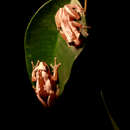Description
(
Anglèis
)
fornì da AmphibiaWeb articles
A medium-sized Afrixalus (males 25–28 mm, females 26–29 mm) from bushland localities in West Africa and the coastal regions of Cameroun to coastal Angola. Dorsum dark with a pattern in silverish white, normally consisting of a triangle on top of the snout continuing into a broad dorsolateral stripe to the groin. A light spot in the lumbar region, sometimes confluent with the dorsolateral stripes, and two light spots on tibia, or tibia uniformly light.Although normally constant in pattern, individuals in some populations can vary considerably, e.g. having a light middorsal stripe or even a uniform light dorsum.Two very similar subspecies are recognised. They are:A.d. dorsalis from Sierra Leone to southern Cameroun. Tibia with two light spots. A. d. regularis Laurent 1951 or A. d. leptosomus (Peters 1877) with a light upper side of tibia. Rio Muni to coastal Angola. It is disputed whether the name leptosomus is rather applicable to a member of the fulvovittatus group.This account was taken from "Treefrogs of Africa" by Arne Schiøtz with kind permission from Edition Chimaira (http://www.chimaira.de/) publishers, Frankfurt am Main. Updated by A. Schiøtz, 2008.
Distribution and Habitat
(
Anglèis
)
fornì da AmphibiaWeb articles
Afrixalus dorsalis is widely distributed and common in bushland localities in the West African forest belt and in forest outliers in the humid savanna. The farthest west I have found it is in eastern Sierra Leone, while apparently suitable localities further west had populations of A. fulvovittatus instead. Towards the east it is recorded commonly from coastal Cameroun to coastal Angola.
Life History, Abundance, Activity, and Special Behaviors
(
Anglèis
)
fornì da AmphibiaWeb articles
The voice consists of an initial sound followed by a number of figures, about 12 per second with a frequency-intensity maximum at 3800–4100 cps. The eggs are white, surrounded by clear jelly. They are deposited in small clumps on leaves which are then folded and glued together. The tadpoles are streamlined with a terminal mouth and a tooth formula of 0/1.

